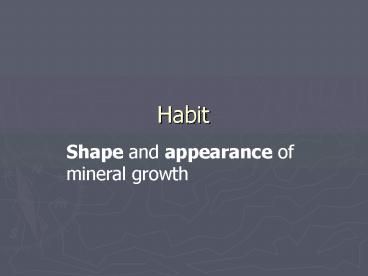Habit PowerPoint PPT Presentation
1 / 30
Title: Habit
1
Habit
Shape and appearance of mineral growth
2
Acicular
- slender, needle-like crystals tourmaline,
hornblende, arsenopyrite, rutile, apatite,
sillimanite
3
Capillary and filiform
- hair-like or thread-like native Au, Ag, Cu
- Very thin
4
Bladed
- elongated crystals flattened like a knife blade
kyanite
5
Dendritic
- arborescent, in slender divergent branches,
somewhat plantlike--native metals, pyrolusite
6
Radiating
- divergent zeolite tremolite talc
- pyrolusite, tourmaline
7
Drusy
- surface covered with a layer of small
crystals--sugar like calcite, quartz,
sphalerite, pyrite
8
Dodecahedral
- Also commonly seen in Garnets, as in this lab
- 12 sided crystal growth.
- NOTE Rhombohedral, Cubic, etc. are also
geometric habits, i.e. how the crystal grows.
9
Fibrous
- aspect ratio 101
- chrysotile asbestos
10
Globular and colloform
- radiating individuals forming small spherical
groups - examples include zeolites, quartz, malachite,
goethite, pyrolusite, hematite
11
Botryoidal
- bunch of grapes, example pyrolusite
12
Reniform
- kidney like, examples hematite, malachite
13
Foliated
- easily separable into plates or leaves
- Micas are the ultimate example
14
Micaceous
- similar to foliated but splits into very thin
sheets muscovite, biotite, chlorite
15
Tabular or lamellar
- flat and plate-like barite, dolomite
16
Granular
- composed of many individual grains of similar
size olivine, garnet
17
Prismatic or columnar
- elongated crystals with identical faces parallel
to a common direction tourmaline, hornblende,
apatite
18
Equant Crystal Habit
- Squashed, pinnacoids (terminating face)
dominant over prisms
19
Types of crystals
- Euhedral
- Subhedral
- Anhedral
- Amorphous
20
Crystal Growth is not always perfect
21
Twinning
- Crystals that are related to one another by some
geometric relation.
22
How does it happen?
- Errors occur during the crystallization of a
mineral - This error can be caused by random flaws in
nature. - During growth phases
- High temperature phase to a low temperature phase
- Siamese twins
- never random and follows certain defined rules
called twin laws.
23
How do we recognize them?
- recognized by penetration angles or notches in
the crystal - Contact
- Planes that forms the boundary between the twins
- Penetration
- Two crystals grew into/out of each other
- Simple or complex
- 2 or more than 2
24
Simple
25
Penetrative
26
Polysynthetic (multiple)
- e.g. Plagioclase
27
Cyclic
28
Parting
- Occurs when a mineral breaks along a twin plane
29
Hopper Crystals
30
Dendrites

